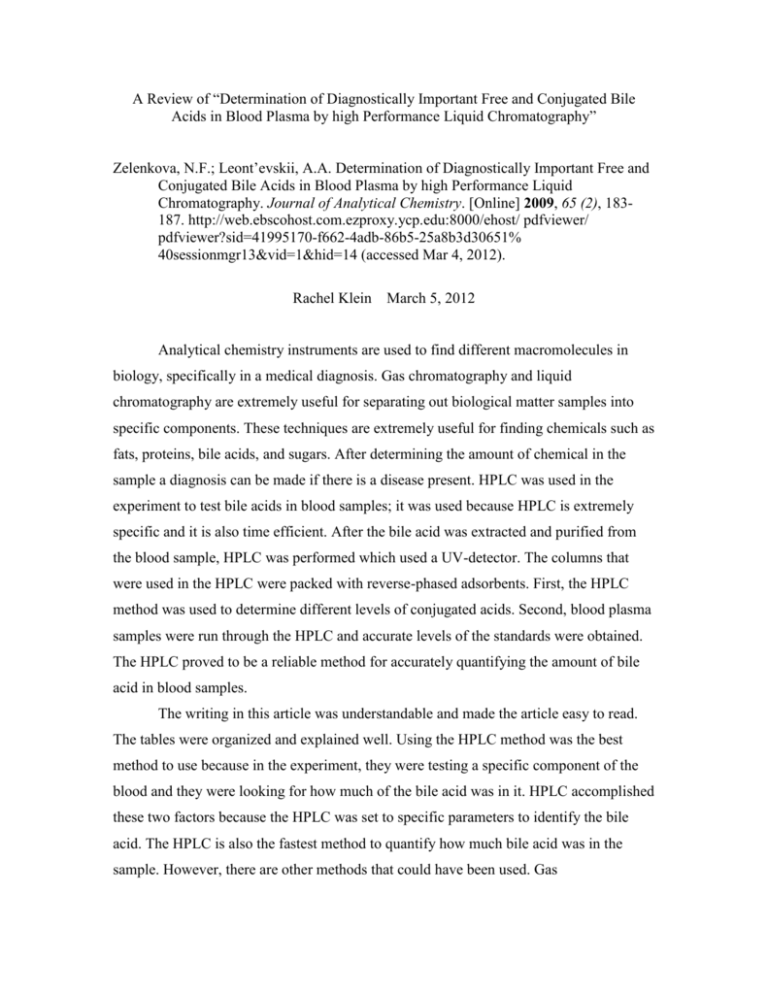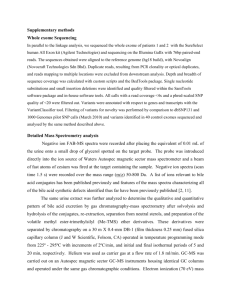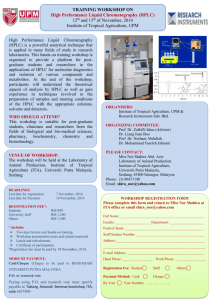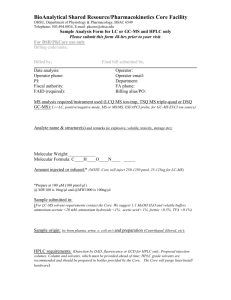Review Paper #1
advertisement

A Review of “Determination of Diagnostically Important Free and Conjugated Bile Acids in Blood Plasma by high Performance Liquid Chromatography” Zelenkova, N.F.; Leont’evskii, A.A. Determination of Diagnostically Important Free and Conjugated Bile Acids in Blood Plasma by high Performance Liquid Chromatography. Journal of Analytical Chemistry. [Online] 2009, 65 (2), 183187. http://web.ebscohost.com.ezproxy.ycp.edu:8000/ehost/ pdfviewer/ pdfviewer?sid=41995170-f662-4adb-86b5-25a8b3d30651% 40sessionmgr13&vid=1&hid=14 (accessed Mar 4, 2012). Rachel Klein March 5, 2012 Analytical chemistry instruments are used to find different macromolecules in biology, specifically in a medical diagnosis. Gas chromatography and liquid chromatography are extremely useful for separating out biological matter samples into specific components. These techniques are extremely useful for finding chemicals such as fats, proteins, bile acids, and sugars. After determining the amount of chemical in the sample a diagnosis can be made if there is a disease present. HPLC was used in the experiment to test bile acids in blood samples; it was used because HPLC is extremely specific and it is also time efficient. After the bile acid was extracted and purified from the blood sample, HPLC was performed which used a UV-detector. The columns that were used in the HPLC were packed with reverse-phased adsorbents. First, the HPLC method was used to determine different levels of conjugated acids. Second, blood plasma samples were run through the HPLC and accurate levels of the standards were obtained. The HPLC proved to be a reliable method for accurately quantifying the amount of bile acid in blood samples. The writing in this article was understandable and made the article easy to read. The tables were organized and explained well. Using the HPLC method was the best method to use because in the experiment, they were testing a specific component of the blood and they were looking for how much of the bile acid was in it. HPLC accomplished these two factors because the HPLC was set to specific parameters to identify the bile acid. The HPLC is also the fastest method to quantify how much bile acid was in the sample. However, there are other methods that could have been used. Gas chromatography could also we used to identify different components in the blood samples. The blood samples would have to be differentiated into a volatile substance for the GC to work properly, and the GC would separate out the different components. However, the GC would not specifically quantify the bile acid and this test method takes a longer time to complete. Gel electrophoresis could have also been used to identify specific proteins in the blood samples. The sample would be separated out by electrical current and specific parts of the sample would be separated. The disadvantage of this method is that it would also not specifically quantify the different components of the sample. Gas chromatography and gel electrophoresis are two alternative methods that could have been used to identify bile acid in conjugated blood samples. The disadvantage to these two methods is that they do not specifically quantify how much bile acid in the sample and also they are more time consuming and this would be a disadvantage when a doctor is trying to quickly diagnosis a patient. HPLC was the best method to use because it is time efficient and also specifically quantifies bile acid.








